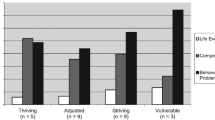Abstract
Changes in placement restrictiveness, as a function of problem type and severity, were examined in a sample of 154 children departing a shelter for runaway and homeless youth. Six problem types were identified using a principal components analysis of youth-reported personal and family problems. Four of the six factors obtained represented youth problem types interpreted as reflecting antisocial/conduct problems, victimization by abuse, risk of suicide, and rebellious youth behaviors. The two remaining problem types were interpreted as a chaotic/aggressive family type and a mixed pattern of youth aggression and parental skill deficiency. An analysis of the problem types indicated that youth at higher risk for suicide, and those who came from more dysfunctional families, departed to living environments that were more restrictive than their placements at entry.
Similar content being viewed by others
References
Bath, H. I., Richey, C. A., & Haapala, D. A. (1992). Child age and outcome correlates in intensive family preservation services.Children and Youth Services Review, 14, 389–406.
Cull, J. G., & Gill, W. S. (1982).Suicide Probability Scale: Manual. Los Angeles: Western Psychological Services.
General Accounting Office. (1989).Homelessness: Homeless and runaway yough receiving services at federally funded shelters (GAO Publication No. HRD-90-45). Washington, DC: Author.
Hawkins, R. P., Almeida, M. C., Fabry, B., & Reitz, A. L. (1992). A scale to measure restrictiveness of living environments for troubled children and youths.Hospital and Community Psychiatry, 43, 54–58.
Kazdin, A. E. (1991). Effectiveness of psychotherapy with children and adolescents.Journal of Consulting and Clinical Psychology, 59, 785–798.
Kinney, J., Haapala, D., & Booth, C. (1991).Keeping families together: The homebuilders model. New York: Aldine de Gruyter.
Kurtz, P. D., Jarvis, S. V., & Kurtz, G. L. (1991). Problems of homeless youths: Empirical findings and human service issues.Social Work, 36, 309–314.
Robins, L. N. (1991). Conduct disorder.Journal of Child Psychology and Psychiatry, 32, 193–212.
Rutter, M., Shaffer, D., & Shepard, M. (1975).A multi-axial classification of child psychiatric disorders: An evaluation of a proposal. Geneva: World Health Organization.
Segal, U. A., & Schwartz, S. (1987). Admission-discharge patterns of children in emergency treatment shelters: Implications for child and youth care practitioners.Child & Youth Care Quarterly, 16, 263–271.
Teare, J. F., Furst, D. W., Peterson, R. W., & Authier, K. (1992). Family reunification following shelter placement: Child, family and program correlates.American Journal of Orthopsychiatry, 62, 142–146.
van Goor-Lambo, G., Orley, J., Poustka, F., & Rutter, M. (1990). Classification of abnormal psychosocial situations: Preliminary report of a revision of a WHO scheme.Journal of Child Psychology and Psychiatry, 31, 229–241.
Author information
Authors and Affiliations
Rights and permissions
About this article
Cite this article
Teare, J.F., Authier, K. & Peterson, R. Differential patterns of post-shelter placement as a function of problem type and severity. J Child Fam Stud 3, 7–22 (1994). https://doi.org/10.1007/BF02233908
Issue Date:
DOI: https://doi.org/10.1007/BF02233908



